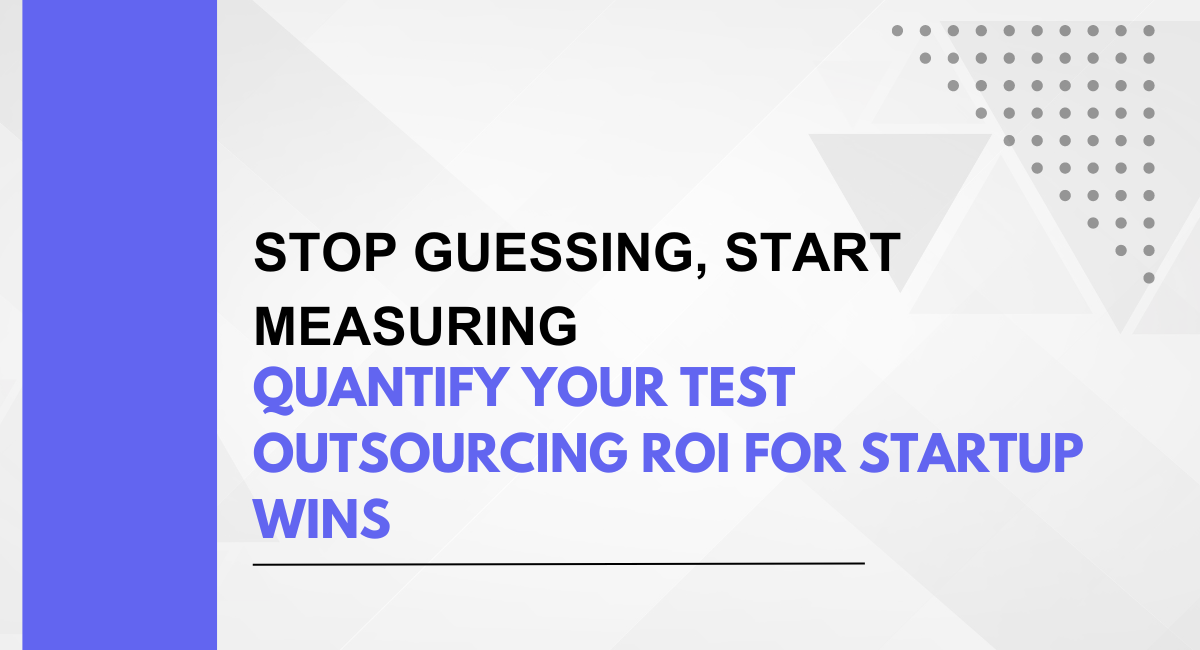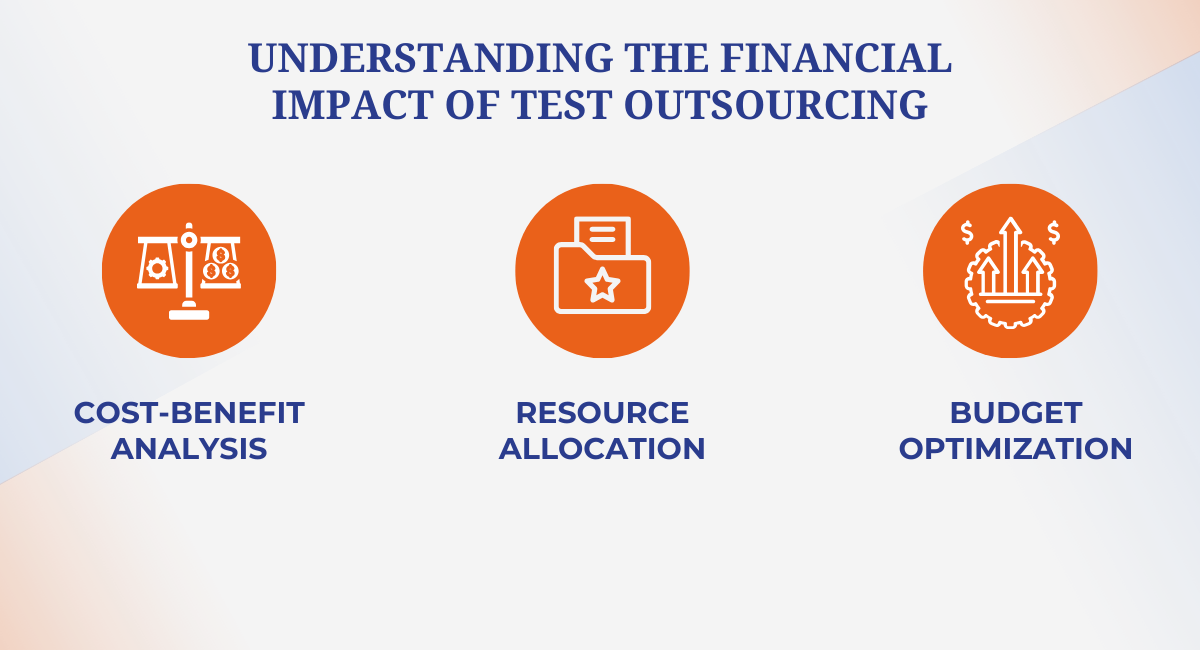Startups operate in a dynamic and competitive environment where delivering a high-quality product is crucial for success. Testing plays a pivotal role in ensuring that a product meets the desired standards, functionality, and user expectations. This introduction provides a brief overview of the significance of testing in startup success, explores the challenges associated with outsourcing testing for startups, and emphasizes the importance of measuring Test Outsourcing ROI (return on investment).
Why Measure ROI in Test Outsourcing?
Effective measurement of Return on Investment (ROI) in test outsourcing is crucial for startups aiming to optimize their testing processes and make informed decisions. This section delves into the reasons behind measuring ROI, emphasizing the financial impact, key performance indicators (KPIs), and the importance of making decisions based on quantitative data.
Understanding the financial impact of test outsourcing
- Cost-Benefit Analysis: Measuring ROI helps startups conduct a comprehensive cost-benefit analysis of test outsourcing. It allows them to compare the expenses associated with outsourcing against the benefits gained, providing a clear financial picture.
- Resource Allocation: Startups often have limited resources. By understanding the financial impact of outsourcing, they can make informed decisions on resource allocation, ensuring that budget constraints are met while maintaining quality testing.
- Budget Optimization: ROI measurement aids in optimizing budgets by identifying areas where costs can be reduced or redirected. This ensures that testing efforts align with the overall financial strategy of the startup.
Identifying key performance indicators (KPIs) for measuring ROI
- Time-to-Market Improvement: Reduced time-to-market is a significant indicator of successful test outsourcing. Monitoring the time saved in identifying and fixing issues allows startups to quantify the impact of outsourcing on product development speed.
- Defect Detection and Reduction: The number and severity of defects found in the testing phase are critical KPIs. A decrease in post-release defects indicates the effectiveness of the outsourcing strategy in ensuring product quality.
- Productivity and Efficiency: Monitoring the efficiency of testing processes, such as the number of test cases executed per unit of time, provides insights into the productivity gains achieved through outsourcing.
- Customer Satisfaction Metrics: Quantifying improvements in customer satisfaction, reflected in positive reviews or increased user engagement, serves as a qualitative measure that complements financial KPIs.
Making informed decisions based on quantitative data
- Data-Driven Decision-Making: ROI measurement provides startups with quantitative data that can be used to make informed decisions. Whether it's scaling up outsourcing efforts or reassessing the strategy, data-driven decisions contribute to long-term success.
- Risk Mitigation: Understanding the financial impact of test outsourcing allows startups to mitigate risks. If the ROI is not meeting expectations, adjustments can be made to the outsourcing strategy before significant resources are invested.
- Continuous Improvement: Regularly measuring ROI fosters a culture of continuous improvement. Startups can iterate on their testing processes, optimizing them over time based on the quantitative insights gained from ROI evaluations.
Critical Metrics for Test Outsourcing Success

Successful test outsourcing for startups involves measuring key metrics that directly impact the overall product development process. The following metrics provide insights into the effectiveness of test outsourcing and contribute to the success of the startup.
Time-to-market improvement
- Test Cycle Time: The time taken to complete testing cycles is a critical metric. A reduction in test cycle time indicates improved efficiency and faster delivery of products to the market.
- Release Frequency: Measuring how often releases occur is indicative of the acceleration in the development process. An increase in release frequency suggests that test outsourcing contributes to a quicker time-to-market.
Bug detection and resolution efficiency
- Defect Density: Defect density measures the number of defects identified per unit of code. A decrease in defect density indicates effective bug detection, showcasing the impact of outsourcing on identifying issues early in the development lifecycle.
- Mean Time to Detect (MTTD) and Mean Time to Resolve (MTTR): MTTD measures the average time taken to detect a defect, while MTTR measures the average time taken to resolve a defect. Shorter MTTD and MTTR values indicate efficient bug identification and resolution, contributing to improved product quality.
Impact on overall product quality
- Customer Reported Defects: Monitoring the number of defects reported by customers post-release provides insights into the overall product quality. A decrease in customer-reported defects suggests that outsourcing contributes to delivering a more robust and reliable product.
- Regression Test Effectiveness: The effectiveness of regression testing is crucial for maintaining product stability. Metrics such as the percentage of test cases passed in regression testing help assess the impact of outsourcing on ensuring that new developments do not introduce regressions.
Cost savings and efficiency gains
- Cost per Defect: Calculating the cost incurred per defect identified and fixed provides insights into the efficiency of the testing process. A decrease in the cost per defect indicates cost savings associated with outsourcing.
- Resource Utilization: Assessing the efficiency of resource utilization, including both in-house and outsourced resources, helps startups understand the impact of outsourcing on optimizing workforce productivity.
- Return on Investment (ROI): The overall financial impact of test outsourcing can be measured through ROI. This metric considers the cost savings, efficiency gains, and improvements in product quality to provide a comprehensive evaluation of the outsourcing strategy's success.
Regular monitoring and analysis of these critical metrics allow startups to assess the success of their test outsourcing efforts and make data-driven decisions for continuous improvement in their product development lifecycle.
Overcoming Challenges in Quantifying ROI in Test Outsourcing
Quantifying Return on Investment (ROI) in test outsourcing can be challenging, especially for startups with unique dynamics. Overcoming obstacles in gathering accurate data, addressing dynamic project requirements, and adapting measurements to the specific needs of startups is crucial for a practical ROI evaluation.
Addressing common obstacles in gathering accurate data
Incomplete Data:
Challenge: Incomplete or inaccurate data can hinder accurate ROI calculations.
Solution: Implement robust data collection mechanisms, ensuring that all relevant data points, such as testing time, defect resolution times, and associated costs, are captured accurately.
Lack of Standardized Metrics:
Challenge: The absence of standardized metrics across different phases of the testing process can complicate ROI assessments.
Solution: Establish transparent and standardized metrics for each stage of testing. This ensures consistency and comparability in data, making ROI calculations more accurate.
Integrating Data from Multiple Sources:
Challenge: Data from various sources, such as in-house teams and external vendors, may be stored differently.
Solution: Invest in integration tools or platforms that can consolidate data from multiple sources into a unified format, facilitating seamless analysis.
By systematically addressing these challenges, startups can enhance the accuracy of ROI measurements, adapt to dynamic project requirements, and customize metrics to suit their unique needs. This ensures that the evaluation process remains robust and contributes to the success of test outsourcing initiatives.
Outsource Test Outsourcing ROI
The measurement of Return on Investment (ROI) in test outsourcing is paramount for startups aiming to thrive in the competitive and dynamic business landscape. This conclusion provides a recap of the importance of measuring ROI, encourages startups to implement quantitative analysis, and offers final thoughts on the role of data-driven decision-making in achieving startup success.
In essence, as startups embark on their journey to success, the integration of quantitative analysis and the systematic measurement of ROI in test outsourcing stand as pillars for informed, strategic, and resilient decision-making. By embracing a data-driven approach, startups can not only weather the challenges of the startup ecosystem but also chart a course towards sustained growth and achievement.
You may also be interested in CI/CD Pipeline Security: Top Best Practices
Book a Demo and experience ContextQA testing tool in action with a complimentary, no-obligation session tailored to your business needs.
We make it easy to get started with the ContextQA tool: Start Free Trial.

